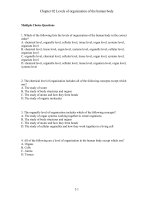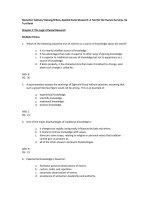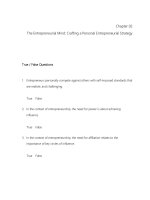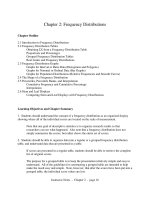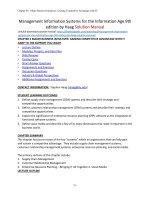Management information systems for the information age 9th edition by haag test bank
Bạn đang xem bản rút gọn của tài liệu. Xem và tải ngay bản đầy đủ của tài liệu tại đây (381.78 KB, 86 trang )
Management Information Systems for the Information Age
9th edition by Haag Test Bank
Link full download test bank: />
Chapter 02 Major Business Initiatives: Gaining Competitive Advantage
with IT Answer Key
Multiple Choice Questions
1.
The path a product or service follows from the originator of the product or
service to the end consumer is called
.
A. inventory control
B. the market strategy
C. the distribution chain
D. transaction processing
A distribution chain is simply the path a product or service follows from the
originator of the product or service to the end consumer.
AACSB: Analytic
Blooms: Remember
Learning Objective: 02-01 Define supply chain management (SCM) systems and describe their strategic and competitive
opportunities
Level of Difficulty: 1 Easy
Topic: Supply Chain Management
2.
Which of the following activities tracks inventory and information among
business processes and across companies?
A. Supply chain management (SCM)
B. Enterprise resource management (ERM)
C. Business intelligence (BI)
D. Distribution information systems (DIS)
Supply chain management (SCM) tracks inventory and information among
business processes and across companies.
AACSB: Analytic
Blooms: Remember
Learning Objective: 02-01 Define supply chain management (SCM) systems and describe their strategic and competitive
opportunities
Level of Difficulty: 1 Easy
Topic: Supply Chain Management
3.
A supply chain management (SCM) system is an IT system that supports supply
chain management activities by:
A. helping decision makers compile useful information to identify and solve
problems and make decisions.
B. automating the tracking of inventory and information among business
processes and across companies.
C. collecting, storing, modifying, and retrieving the transactions of an
organization.
D. providing easy access to both internal and external information relevant to
meeting the strategic goals of the organization.
A supply chain management (SCM) system is an IT system that supports supply
chain management activities by automating the tracking of inventory and
information among business processes and across companies.
AACSB: Technology
Blooms: Understand
Learning Objective: 02-01 Define supply chain management (SCM) systems and describe their strategic and competitive
opportunities
Level of Difficulty: 2 Medium
Topic: Supply Chain Management
4.
Most large manufacturing companies use
processes, which ensure that the
right parts are available as products in process move down the assembly line.
A. ready manufacturing
B. just-in-time manufacturing
C. hyper manufacturing
D. immediate production
Most large manufacturing companies use just-in-time manufacturing processes,
which ensure that the right parts are available as products in process move
down the assembly line.
AACSB: Analytic
Blooms: Remember
Learning Objective: 02-01 Define supply chain management (SCM) systems and describe their strategic and competitive
opportunities
Level of Difficulty: 1 Easy
Topic: Supply Chain Management
5.
Just-in-time (JIT) is:
A. a method for continuously improving the quality of products and processes.
B. a method of manufacturing where large inventories need to be maintained.
C. a method for producing or delivering a product or service precisely when the
customer wants it.
D. a method that considers the expenditure of resources for any goal other than
the creation of value for the end customer to be wasteful.
Just-in-time (JIT) is a method for producing or delivering a product or service
just at the time the customer wants it.
AACSB: Technology
Blooms: Understand
Learning Objective: 02-01 Define supply chain management (SCM) systems and describe their strategic and competitive
opportunities
Level of Difficulty: 2 Medium
Topic: Supply Chain Management
6.
If you were to purchase a car and the assembly of that car was dictated by your
requirements before it was manufactured, you would be utilizing which type of
manufacturing process?
A. Customer-driven manufacturing
B. Just-in-time manufacturing
C. Customized construction
D. Transaction-based production
Most large manufacturing companies use just-in-time manufacturing processes,
which ensure that the right parts are available as products in process move
down the assembly line. Just-in-time (JIT) is a method for producing or
delivering a product or service just at the time the customer wants it.
AACSB: Reflective Thinking
AACSB: Technology
Blooms: Apply
Learning Objective: 02-01 Define supply chain management (SCM) systems and describe their strategic and competitive
opportunities
Level of Difficulty: 3 Hard
Topic: Supply Chain Management
7.
Which type of transportation uses multiple channels to transport products from
the manufacturing location to the customer destination?
A. Hyper
B. Divergent
C. Inter-modal
D. Complex
Inter-modal transportation is the use of multiple channels of transportation—
railway, truck, boat, and so on—to move products from origin to destination.
AACSB: Analytic
Blooms: Remember
Learning Objective: 02-01 Define supply chain management (SCM) systems and describe their strategic and competitive
opportunities
Level of Difficulty: 1 Easy
Topic: Supply Chain Management
8.
Which of the following supply chain activities ensures that the right quantity of
parts arrive at the right time for production or sale?
A. Logistics
B. Production
C. Cost and Price
D. Fulfillment
Fulfillment ensures that the right quantity of parts for production or products for
sale, arrive at the right time.
AACSB: Analytic
Blooms: Remember
Learning Objective: 02-01 Define supply chain management (SCM) systems and describe their strategic and competitive
opportunities
Level of Difficulty: 1 Easy
Topic: Supply Chain Management
9.
Which of the following supply chain activities keeps the cost of transporting
materials as low as possible consistent with safe and reliable delivery?
A. Logistics
B. Production
C. Cost and Price
D. Fulfillment
Logistics keeps the cost of transporting materials as low as possible consistent
with safe and reliable delivery.
AACSB: Analytic
Blooms: Remember
Learning Objective: 02-01 Define supply chain management (SCM) systems and describe their strategic and competitive
opportunities
Level of Difficulty: 1 Easy
Topic: Supply Chain Management
10.
Which of the following supply chain activities ensures no sales are lost because
shelves are empty?
A. Logistics
B. Production
C. Cost and Price
D. Revenue and profit
Revenue and profit ensures no sales are lost because shelves are empty.
AACSB: Analytic
Blooms: Remember
Learning Objective: 02-01 Define supply chain management (SCM) systems and describe their strategic and competitive
opportunities
Level of Difficulty: 1 Easy
Topic: Supply Chain Management
11.
In relation to SCM, what is an information partnership?
A. Sharing production information with potential customers
B. Two or more companies cooperating by integrating their IT systems
C. Competitive suppliers providing production schedules to the manufacturer
D. Functional areas within your business sharing information
Information partnership refers to two or more companies cooperating by
integrating their IT systems, thereby providing customers with the best of what
each can offer.
AACSB: Technology
Blooms: Understand
Learning Objective: 02-01 Define supply chain management (SCM) systems and describe their strategic and competitive
opportunities
Level of Difficulty: 2 Medium
Topic: Supply Chain Management
12.
You visit your local florist to order flowers for a party you were preparing for.
The florist, however, did not have the type of flower arrangement you hoped for
but the florist was able to immediately find, order, and deliver this arrangement
directly to your home from their supplier. What kind of relationship does this
represent?
A. An information partnership
B. A collaborative business
C. Dynamic communication
D. Customer sharing
Information partnership refers to two or more companies cooperating by
integrating their IT systems, thereby providing customers with the best of what
each can offer.
AACSB: Reflective Thinking
Blooms: Apply
Learning Objective: 02-01 Define supply chain management (SCM) systems and describe their strategic and competitive
opportunities
Level of Difficulty: 3 Hard
Topic: Supply Chain Management
13.
Which of the following systems uses information about customers to gain
insights into their needs, wants, and behaviors in order to serve them better?
A. SCM
B. TPS
C. ERP
D. CRM
A customer relationship management (CRM) system uses information about
customers to gain insights into their needs, wants, and behaviors in order to
serve them better.
AACSB: Technology
Blooms: Remember
Learning Objective: 02-02 Define customer relationship management (CRM) systems and describe their strategic and competitive
opportunities
Level of Difficulty: 1 Easy
Topic: Customer Relationship Managemen
14.
E-mail, fax, phone, and the Web are all ways in which most companies interact
with their customers. What term describes this method of communication?
A. Inter-modal communication
B. Customer collaborative systems
C. Multi-channel service delivery
D. Multi-path convergence
Multi-channel service delivery is the term that describes a company's offering
multiple ways in which customers can interact with it. E-mail, fax, phone, and the
Web are all ways in which most companies interact with their customers.
AACSB: Technology
Blooms: Remember
Learning Objective: 02-02 Define customer relationship management (CRM) systems and describe their strategic and competitive
opportunities
Level of Difficulty: 1 Easy
Topic: Customer Relationship Management
15.
Which of the following is a fundamental goal of CRM systems?
A. To produce and deliver a product or service at the time the customer wants
it.
B. To lower the costs of maintaining inventory systems.
C. To manage and track customer interactions.
D. To continuously improve the quality of products and processes.
A fundamental goal of a CRM system is the management and tracking of all
customer interactions. The communications within the various channels must be
organized and carefully recorded for each customer.
AACSB: Technology
Blooms: Understand
Learning Objective: 02-02 Define customer relationship management (CRM) systems and describe their strategic and competitive
opportunities
Level of Difficulty: 2 Medium
Topic: Customer Relationship Management
16.
What is the difference between SCM and CRM?
A. CRM records information about products and services; SCM records
information about customers.
B. CRM stores and processes transactional information; CRM stores and
processes business intelligence.
C. SCM manages production and delivery information; CRM manages customer
information.
D. CRM records and processes operational data; SCM records and processes
tactical information.
A supply chain management (SCM) system is an IT system that supports supply
chain management activities by automating the tracking of inventory and
information among business processes and across companies. A customer
relationship management (CRM) system uses information about customers to
gain insights into their needs, wants, and behaviors in order to serve them
better.
AACSB: Technology
Blooms: Create
Learning Objective: 02-01 Define supply chain management (SCM) systems and describe their strategic and competitive
opportunities
Learning Objective: 02-02 Define customer relationship management (CRM) systems and describe their strategic and competitive
opportunities
Level of Difficulty: 3 Hard
Topic: Customer Relationship Management
17.
One of the primary functions of CRM is the sales force automation (SFA) system.
What is SFA's purpose?
A. To track all the steps in the sales process
B. To track the movements of salespeople
C. To track products as they move from inventory to the customer
D. To track the increase or decrease in sales
Sales force automation (SFA) systems automatically track all the steps in the
sales process.
AACSB: Technology
Blooms: Understand
Learning Objective: 02-02 Define customer relationship management (CRM) systems and describe their strategic and competitive
opportunities
Level of Difficulty: 2 Medium
Topic: Customer Relationship Management
18.
Which of the following CRM functions empower sales representatives with
information and business intelligence focused on customer buying patterns and
needs?
A. Customer service and support
B. Analytics
C. Sales force automation
D. Marketing campaign management
SFA systems empower sales representatives with information and business
intelligence focused on customer buying patterns and needs. They help people
at all levels of the organization to forecast future sales.
AACSB: Technology
Blooms: Understand
Learning Objective: 02-02 Define customer relationship management (CRM) systems and describe their strategic and competitive
opportunities
Level of Difficulty: 2 Medium
Topic: Customer Relationship Management
19.
Which of the following steps is included in the sales process?
A. Analytics
B. Contact management
C. Customer service and support
D. Marketing campaign management
Sales force automation (SFA) systems automatically track all the steps in the
sales process. The sales process contains many steps, including contact
management, sales lead tracking, sales forecasting and order management, and
product knowledge.
AACSB: Technology
Blooms: Understand
Learning Objective: 02-02 Define customer relationship management (CRM) systems and describe their strategic and competitive
opportunities
Level of Difficulty: 2 Medium
Topic: Customer Relationship Management
20.
are functions that support CRM after the sale.
A. Customer service and support
B. Analytics
C. Sales force automation
D. Marketing campaign management
Customer service and support are functions that support CRM after the sale.
These vitally important subsystems of a CRM system enable businesses to
provide prompt and effective customer service and accurate and timely product
support. Customer service and support functions are definitely multi-channel,
attempting to meet the service needs of customers by phone, e-mail, Web, text
message, Facebook presence, and so on.
AACSB: Technology
Blooms: Understand
Learning Objective: 02-02 Define customer relationship management (CRM) systems and describe their strategic and competitive
opportunities
Level of Difficulty: 2 Medium
Topic: Customer Relationship Management
21.
Which of the following systems is the primary interface to customers and sales
channels, typically used to support customers or sales?
A. Back office systems
B. Front office systems
C. Decision support systems
D. Executive information systems
The front office systems are the primary interface to customers and sales
channels; they send all the customer information they collect to the database.
AACSB: Technology
Blooms: Understand
Learning Objective: 02-02 Define customer relationship management (CRM) systems and describe their strategic and competitive
opportunities
Level of Difficulty: 2 Medium
Topic: Customer Relationship Management
22.
Which systems are typically used to fulfill and support customer orders?
A. Back office systems
B. Front office systems
C. Side office systems
D. Decision support systems
The back office systems are used to fulfill and support customer orders and they
also send all their customer information to the database.
AACSB: Technology
Blooms: Understand
Learning Objective: 02-02 Define customer relationship management (CRM) systems and describe their strategic and competitive
opportunities
Level of Difficulty: 2 Medium
Topic: Customer Relationship Management
23.
What is the difference between front and back office systems?
A. Front office systems are external systems; back office systems are internal.
B. Front office systems are Web based; back office systems are built on
database systems.
C. Front office systems process information in the beginning of a customer's
transaction; back office systems process information at the end of the
customer's transaction.
D. Front office systems focus on getting the sale; back office systems focus on
follow-up.
The front office systems are the primary interface to customers and sales
channels; they send all the customer information they collect to the database.
The back office systems are used to fulfill and support customer orders and they
also send all their customer information to the database. The CRM system
analyzes and distributes the customer information and provides the
organization with a complete view of each customer's experience with the
business.
AACSB: Technology
Blooms: Create
Learning Objective: 02-02 Define customer relationship management (CRM) systems and describe their strategic and competitive
opportunities
Level of Difficulty: 3 Hard
Topic: Customer Relationship Management
24.
is a delivery model for software in which you pay for software on a payper-use basis instead of buying the software outright.
A. SaaS
B. IaaS
C. PaaS
D. DSS
Software-as-a-service (SaaS) is a delivery model for software in which you pay
for software on a pay-per-use basis instead of buying the software outright.
AACSB: Technology
Blooms: Remember
Learning Objective: 02-02 Define customer relationship management (CRM) systems and describe their strategic and competitive
opportunities
Level of Difficulty: 1 Easy
Topic: Customer Relationship Management
25.
was one of the first to offer SaaS for CRM software.
A. Oracle
B. SAP
C. Salesforce.com
D. Microsoft
Salesforce.com was one of the first to offer such a model as SaaS for CRM
software, as was NetSuite.
AACSB: Technology
Blooms: Remember
Learning Objective: 02-02 Define customer relationship management (CRM) systems and describe their strategic and competitive
opportunities
Level of Difficulty: 1 Easy
Topic: Customer Relationship Management


